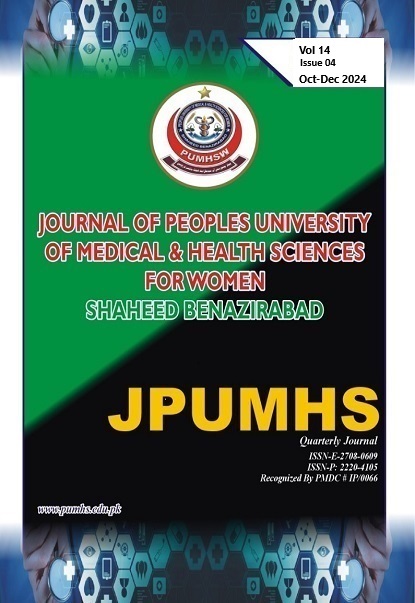EVALUATING THE RISK OF PRE-ECLAMPSIA IN PREGNANT WOMEN WITH HYPEREMESIS GRAVIDARUM IN THE SECOND TRIMESTER.
JPUMHS;2024:14:04,79-86. http://doi.org/10.46536/jpumhs/2024/14.04.563
Keywords:
Pre-eclampsia, Hyperemesis Gravidarum, Pregnancy, Hypertension, Maternal Health.Abstract
BACKGROUND: Hypertensive disorders of pregnancy, particularly pre-eclampsia, are a
leading cause of maternal and neonatal mortality. Hyperemesis gravidarum HG in the second
trimester has been linked to abnormal placentation, potentially increasing the risk of pre
eclampsia. OBJECTIVE: To determine the frequency of pre-eclampsia in patients diagnosed
with hyperemesis gravidarum in the second trimester. METHODS: Using a descriptive
cross-sectional research design, the study was conducted for six months at the Obstetrics and
Gynecology Department of Lady Reading Hospital in Peshawar, Pakistan. During their
second trimester, 100 pregnant women with hyperemesis gravidarum were enrolled. By
assessing their demographic, medical, obstetric, and pre-eclampsia indicators, research data
was gathered from pregnant women who were diagnosed with hyperemesis gravidarum in the
second trimester. Analysis of the data was done using SPSS version 21. RESULTS: On
average, each participant in this research was 27 years old standard deviation: 10.88. While
34% of research participants had already given birth twice, 66% had only experienced one
pregnancy. Pregnancy duration for research participants was less than 12 weeks, with a
standard variation of 5.94 weeks. In the second trimester, 47% of women who experienced
hyperemesis gravidarum went on to develop pre-eclampsia. CONCLUSION: According to
the study, pregnant women who have hyperemesis gravidarum during the second trimester
are more likely to develop pre-eclampsia. These findings highlight the significance of
regularly monitoring expectant mothers and initiating therapy for these individuals as soon as
possible.
Downloads
Downloads
Published
How to Cite
Issue
Section
License

This work is licensed under a Creative Commons Attribution-NoDerivatives 4.0 International License.




